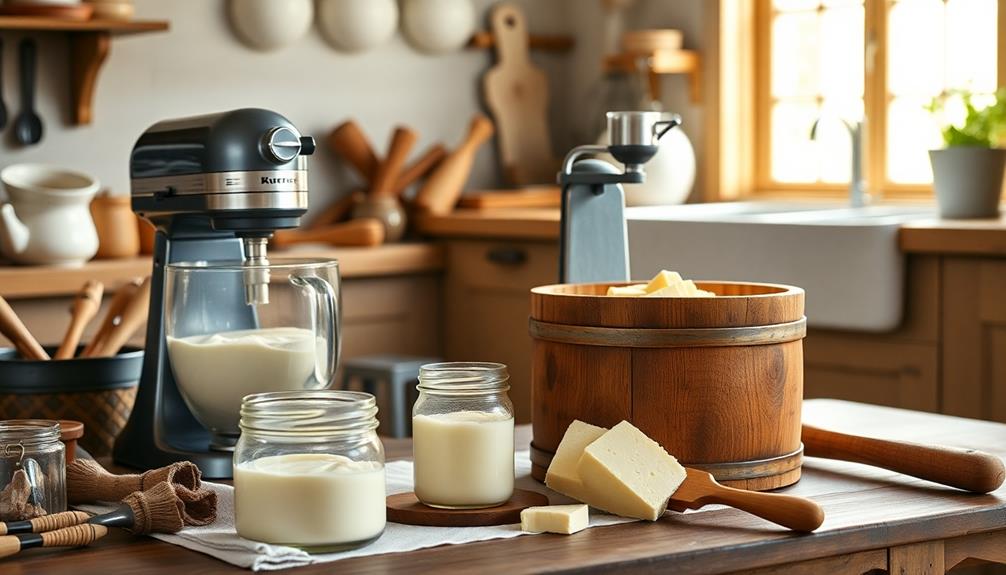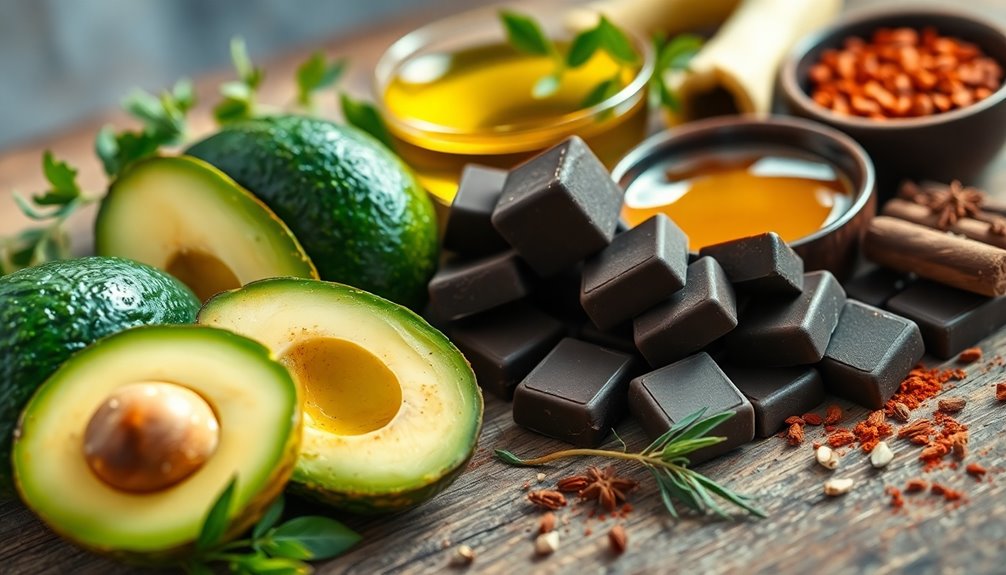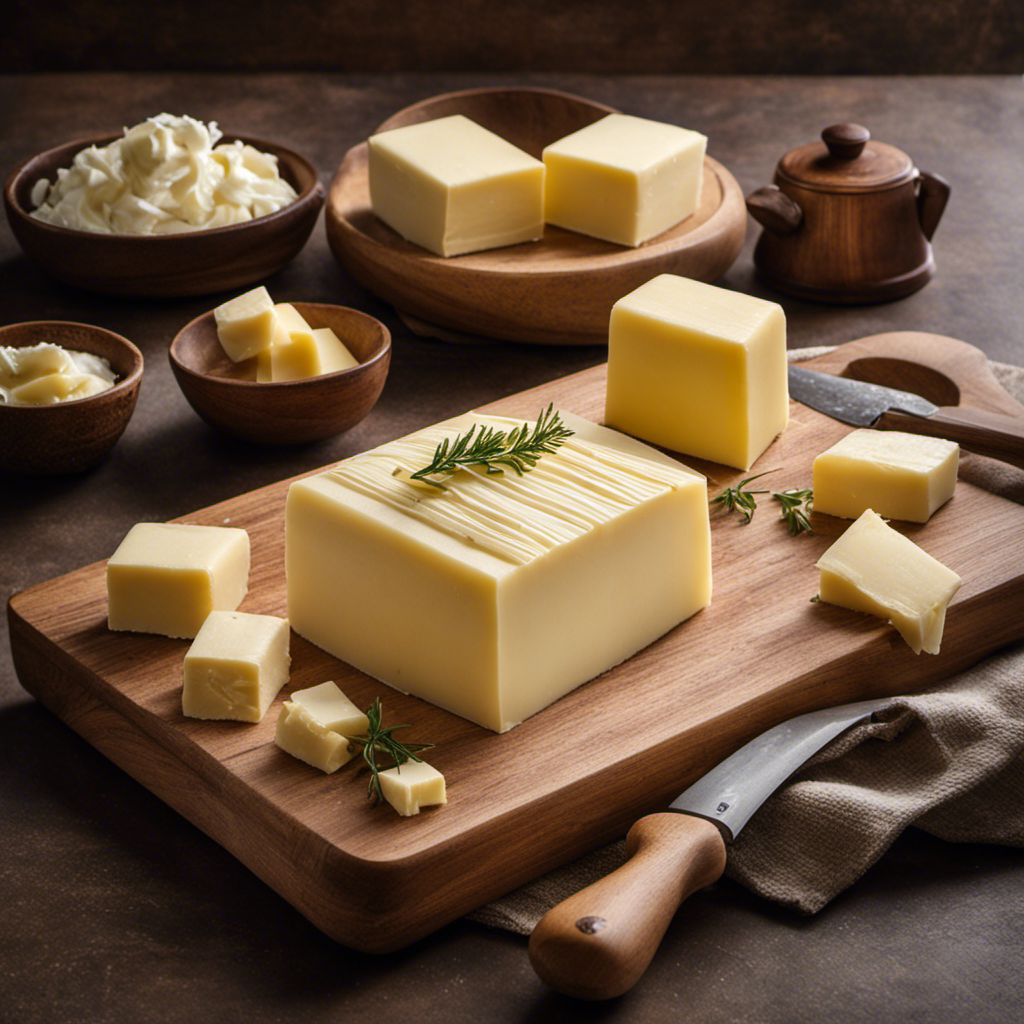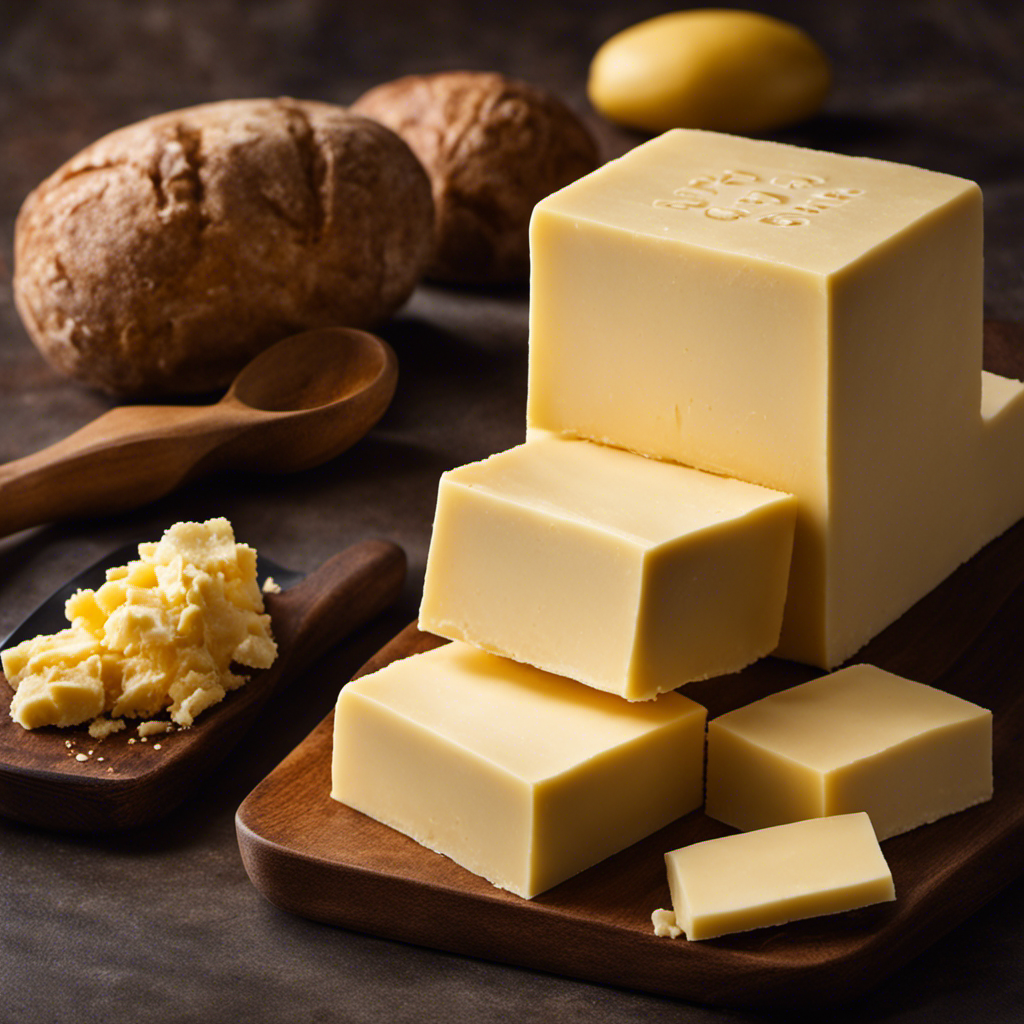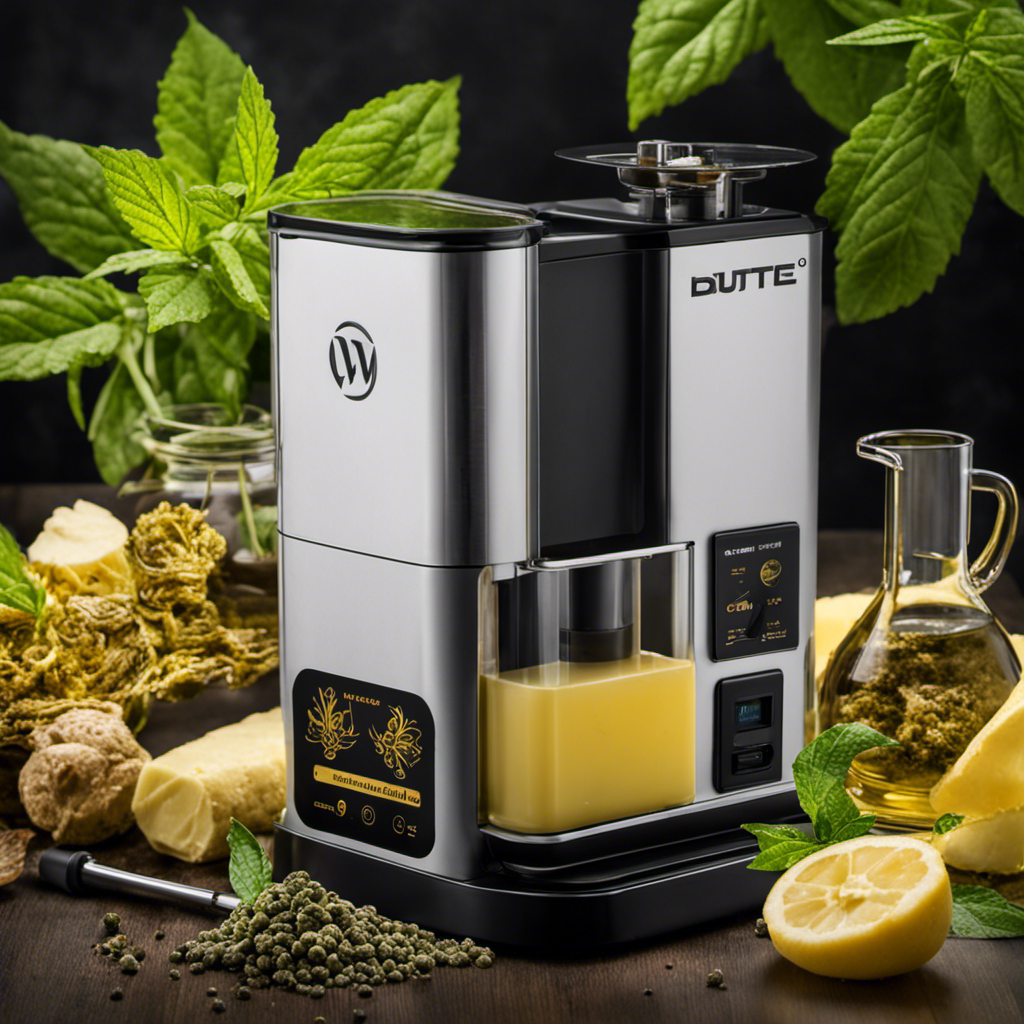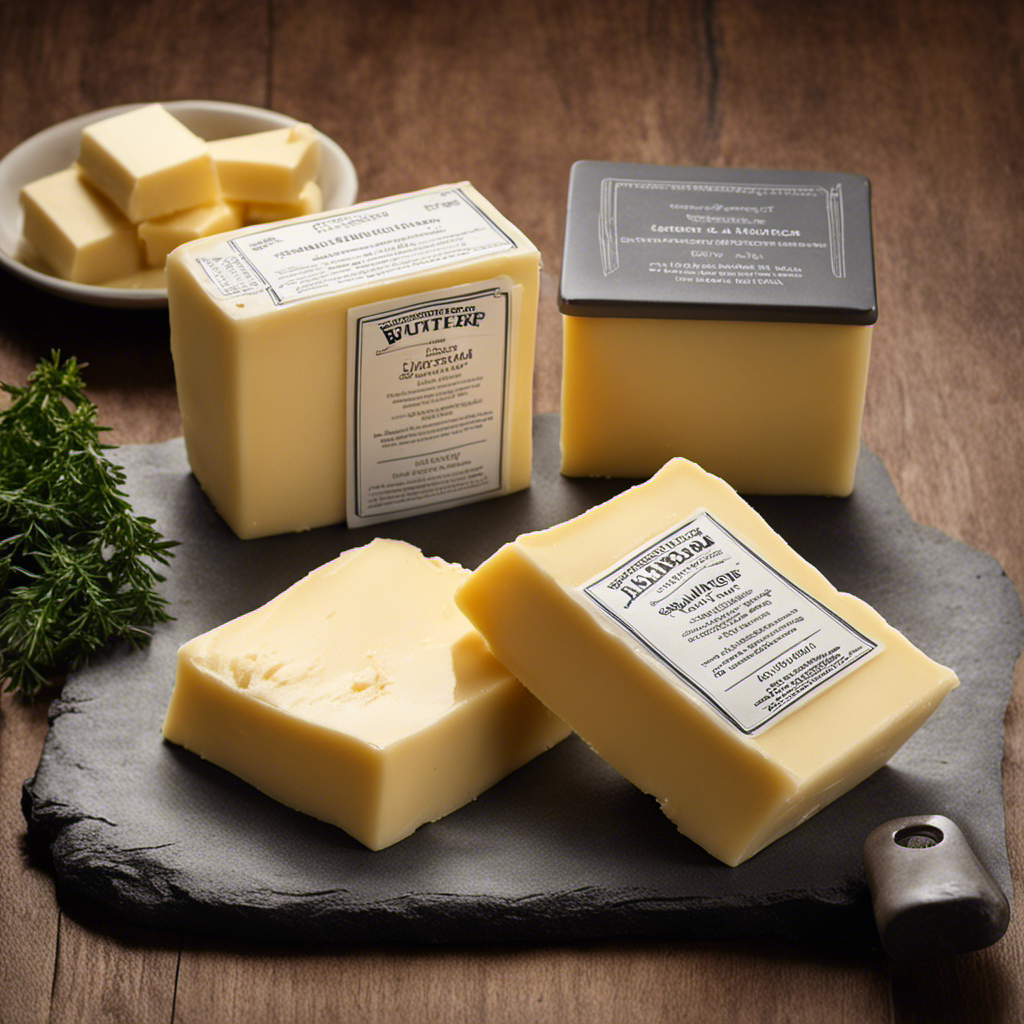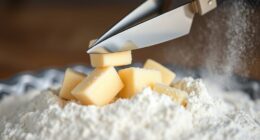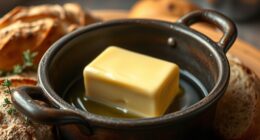The history of butter-making technologies takes you through a fascinating evolution. You start with ancient methods where simple churning in clay or wooden containers was common. Geography played a role, impacting local resources and flavors. During the Middle Ages, advancements in churning techniques improved production efficiency. The Industrial Revolution transformed butter production through mechanization and pasteurization, enhancing safety and shelf-life. Today, modern methods include high-temperature pasteurization and vacuum processing for superior quality. Artisan producers are even innovating with unique flavors. There's so much more to discover about each stage of this tasty journey.
Key Takeaways
- Ancient civilizations utilized simple churning techniques with clay or wooden containers, often enhancing flavor through natural fermentation.
- The Industrial Revolution introduced mechanized butter production, increasing efficiency and enabling consistent quality across larger batches.
- Innovations in dairy cattle breeding led to higher milk yields and improved butter quality through selective breeding and better feeding practices.
- Modern butter production employs advanced techniques like HTST pasteurization and vacuum processing for enhanced safety and prolonged shelf life.
- Artisan butter makers focus on unique flavors and sustainability, experimenting with local ingredients and eco-friendly practices to cater to consumer demand.
Ancient Butter Making Techniques
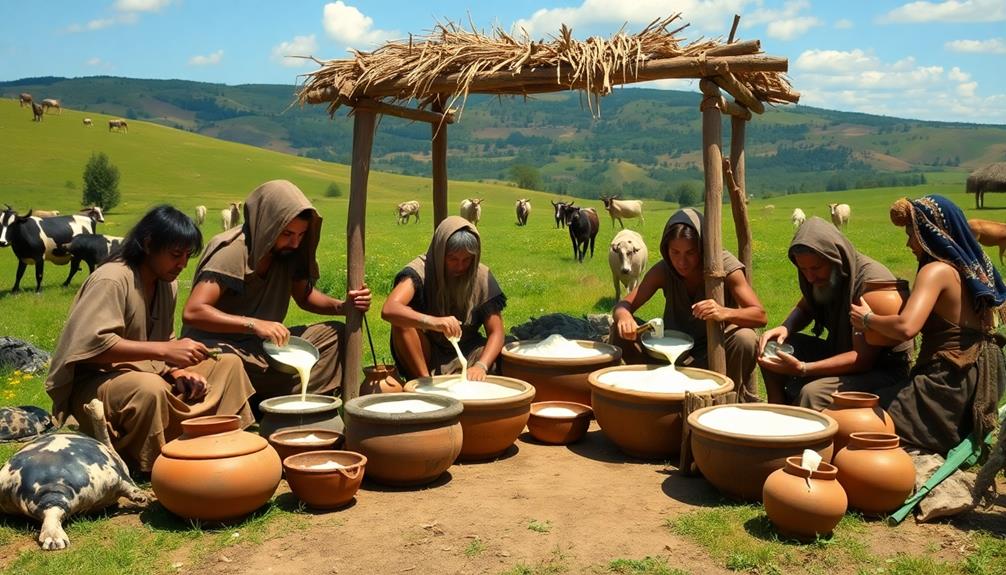
In ancient times, people developed various techniques for making butter that laid the foundation for modern practices. You'd find that many cultures utilized simple methods involving milk or cream, often churning it in containers made from clay or wood.
Imagine the rhythmic motion as they turned the churn, transforming liquid cream into creamy butter. These methods, which date back to early civilizations such as the ancient Egyptians and Greeks, often relied on natural fermentation. By allowing milk to sit, it would sour slightly, making churning easier and enhancing the flavor.
In some regions, they even used animal skins as containers, taking advantage of their natural properties to aid in the butter-making process.
As you explore these ancient practices, you'll see how regional resources influenced methods. For example, in colder climates, people often kept their milk in cool areas to encourage butter development slowly, while warmer regions used heat to speed things up.
The Role of Geography
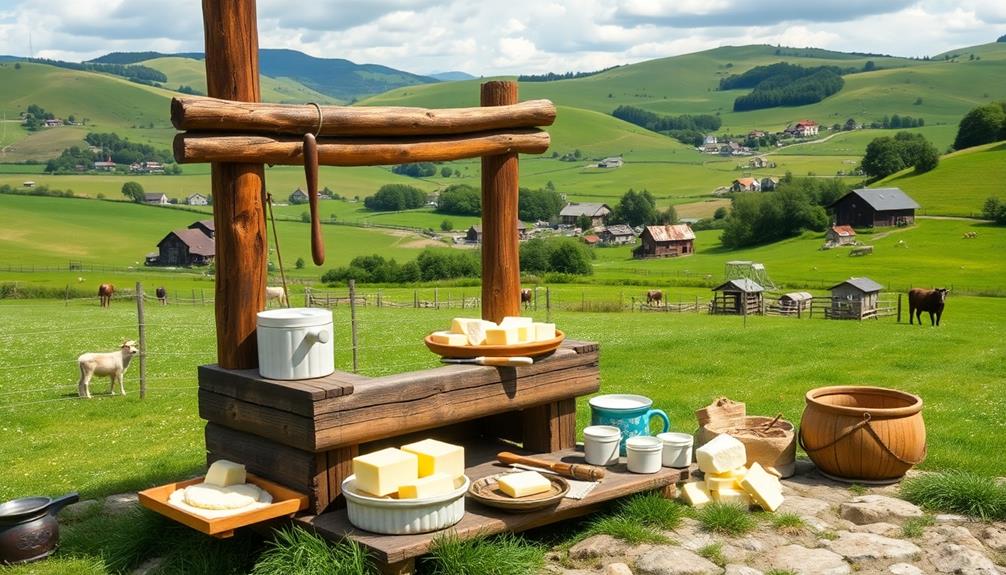
Geography plays an essential role in butter making, shaping both the regional climate and the availability of local ingredients.
Depending on where you are, the temperature and humidity can greatly affect how butter is produced.
You'll also find that different areas have unique resources that influence the flavors and textures of their butter.
Regional Climate Influence
Often overlooked, regional climate plays an important role in the evolution of butter-making technologies. Your environment directly affects the milk's composition, which in turn influences how butter is produced.
For instance, in warmer climates, milk tends to have a higher bacterial load, making it vital to develop methods that guarantee cleanliness and preservation during the butter-making process.
Conversely, cooler regions allow for more natural fermentation, which can enhance flavor profiles in butter. You might notice that traditional methods in these areas often emphasize the use of raw milk, allowing for rich, complex flavors to develop.
Humidity also impacts butter consistency. In humid climates, you'll find that butter can become softer, requiring specific techniques to maintain a desirable texture. As a result, artisans in these regions have historically adapted their practices to achieve the best results.
In essence, understanding your regional climate shapes your approach to butter making. It influences everything from the choice of techniques to the final product's flavor and texture.
Local Ingredients Availability
The availability of local ingredients greatly shapes butter-making practices, influencing both the quality and character of the final product. When you consider where butter's primary components—milk and cream—come from, you realize geography plays a significant role.
Regions with lush pastures often yield richer milk, resulting in butter that's creamier and more flavorful. If you live in an area where dairy farming thrives, you've likely got access to fresher and higher-quality ingredients, which can elevate your butter-making experience.
In contrast, if you're in a region with limited dairy resources, you may find it challenging to produce butter with the same richness. You might need to rely on imported milk or cream, which can affect the taste and texture of your butter.
Additionally, local availability of herbs, spices, or even fruits can inspire unique flavor profiles, allowing you to experiment with your butter creations.
Ultimately, you can see how local ingredients not only dictate the quality of butter but also inspire creativity in your butter-making practices, making every batch unique to your geographical context.
Innovations in the Middle Ages
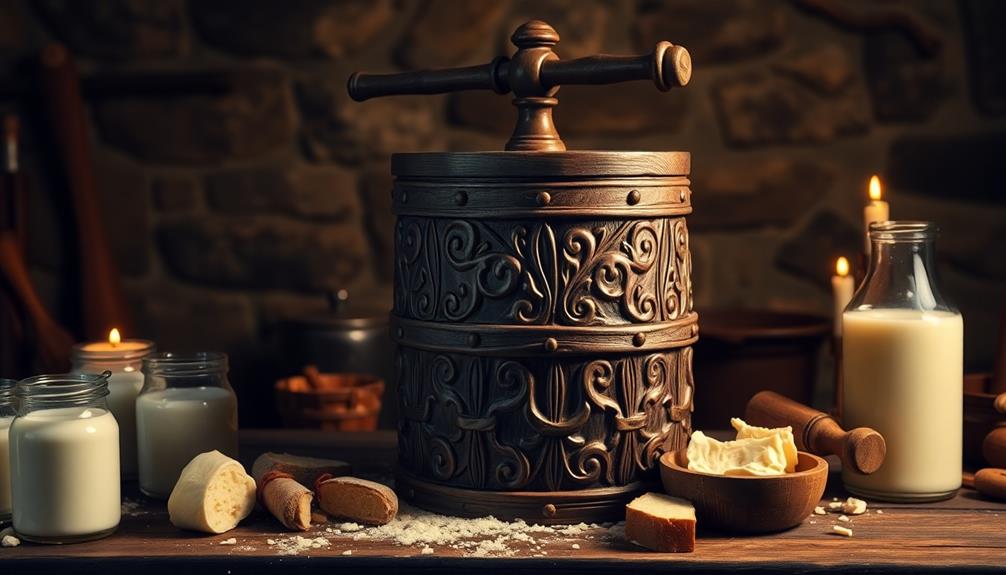
In the Middle Ages, you'd notice significant advancements in butter making that transformed traditional practices.
Churning techniques evolved, allowing for more efficient butter production, while improvements in dairy cattle breeding led to richer milk and better quality butter.
These innovations marked a pivotal shift in how butter was made and enjoyed across Europe.
Churning Techniques Evolved
During the Middle Ages, advancements in churning techniques transformed butter making from a laborious task into a more efficient process.
You'd notice that traditional wooden churns began evolving into more practical designs. The introduction of the barrel churn, for instance, allowed for larger quantities of cream to be processed at once. This innovation not only sped up the churning time but also improved the texture of the butter.
As you churned, the use of paddles became more common, which made it easier to agitate the cream. This method reduced the physical effort required, allowing you to produce butter with less strain.
Additionally, some artisans experimented with different materials for churn construction, like clay and metal, enhancing durability and functionality.
The excitement of these innovations didn't stop there. You'd find that the use of temperature control became essential; warming the cream slightly before churning yielded better results.
These developments led to consistent quality and taste, making butter a staple in households and markets. By embracing these new techniques, you not only improved efficiency but also contributed to the growing demand for butter during this period.
Dairy Cattle Breeding Advances
Significant improvements in dairy cattle breeding emerged in the Middle Ages, revolutionizing butter production. You'd notice that as farmers began to selectively breed their cattle, the quality and quantity of milk increased substantially. This period marked a shift in how dairy farmers approached cattle management, leading to innovations that made butter production more efficient and economically viable.
Here are some key advancements during this time:
- Selective Breeding: Farmers chose specific traits for higher milk yield and better fat content.
- Improved Feeding Practices: Cattle diets were enhanced with better forage and grains, boosting milk production.
- Healthier Breeds: Breeding programs focused on disease resistance, resulting in stronger herds.
- Record Keeping: Farmers started documenting breeding practices and milk yields, leading to better decision-making.
- Cross-Breeding Techniques: Experimentation with different breeds helped farmers discover ideal combinations for milk quality.
These innovations not only improved the butter-making process but also laid the groundwork for modern dairy farming. You can see how the Middle Ages were instrumental in shaping the future of dairy cattle breeding, ultimately benefiting butter production for generations to come.
The Industrial Revolution's Impact
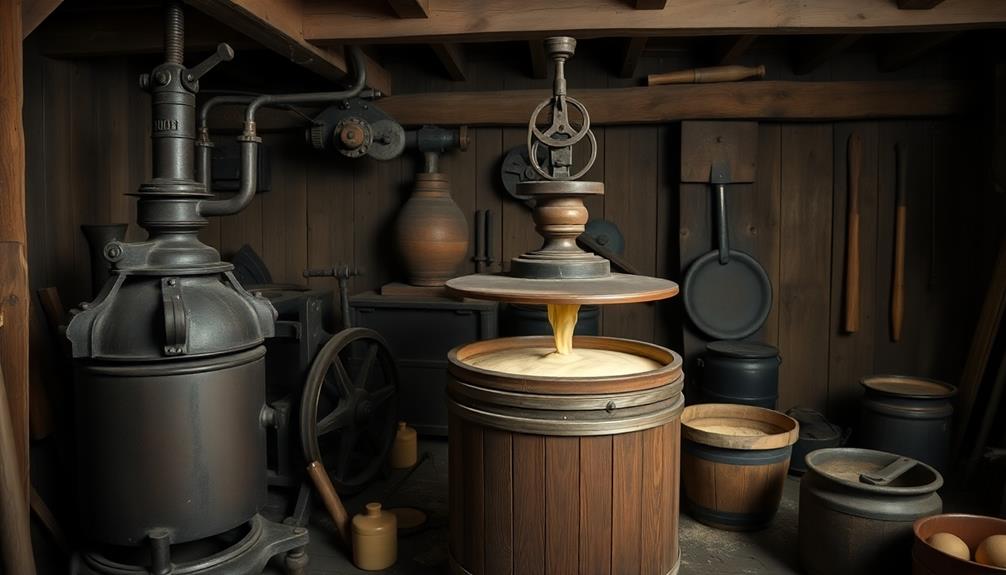
As the Industrial Revolution swept across Europe and North America in the 18th and 19th centuries, it transformed traditional butter-making methods into more efficient processes.
You'd notice that the shift from hand-churning to mechanized methods greatly increased production capacity. Dairy farms began to adopt steam-powered equipment, allowing for larger batches of cream to be churned simultaneously, which reduced the time and labor needed to make butter.
This era also ushered in the rise of commercial butter production. You'd see factories popping up, specializing in butter-making, which enabled consistent quality and uniformity in the product.
With the advent of refrigeration, storage became easier, allowing butter to be transported over long distances without spoilage.
Additionally, the introduction of pasteurization processes helped improve the safety and shelf life of dairy products, including butter.
As you explored the markets, you'd find a wider variety of butter products becoming available, catering to diverse consumer preferences.
Mechanical Churns and Their Evolution
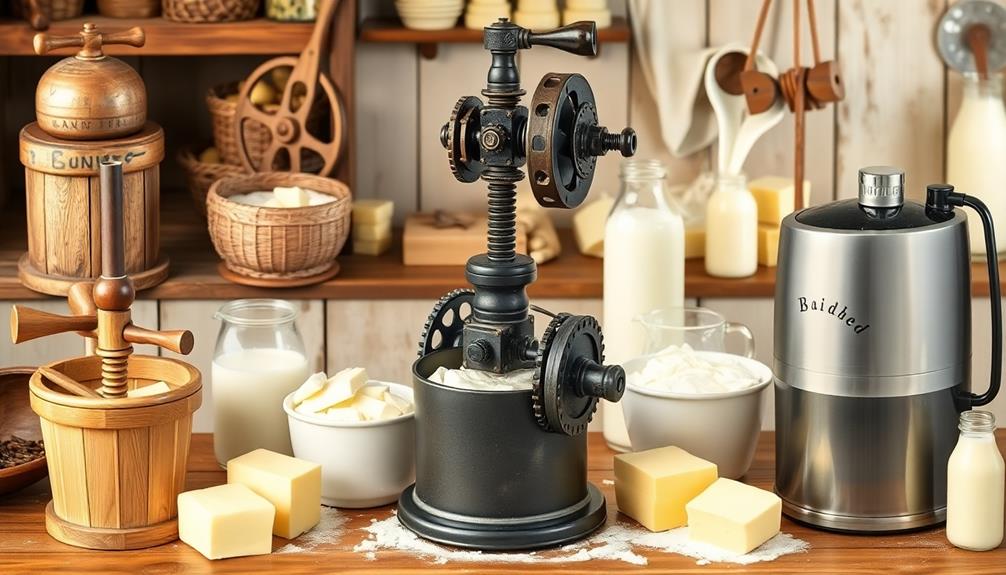
Mechanical churns revolutionized the butter-making process, making it faster and more efficient than ever before. These innovations allowed for the production of butter with a fat content typically ranging from 80% to 82%, guaranteeing a creamy texture and enhanced flavor.
You'll find that these innovative devices reduced the labor and time involved, transforming how butter was produced in both homes and dairies. Here are some key aspects of mechanical churns that shaped their evolution:
- Increased Capacity: Mechanical churns could process larger quantities of cream in a single batch.
- Consistent Results: They guaranteed uniform texture and flavor, making it easier to produce high-quality butter.
- Labor-Saving: These machines minimized the physical effort required compared to traditional hand-churning methods.
- Variety of Designs: From hand-cranked models to power-driven machines, churn designs have adapted to meet different needs.
- Accessibility: As they became more affordable, mechanical churns were widely adopted, democratizing butter production.
As you explore the advancements in butter-making technology, consider how mechanical churns paved the way for modern dairy practices. Their development not only improved efficiency but also set the stage for innovations that would follow, ultimately shaping the future of butter production.
Pasteurization and Butter Quality
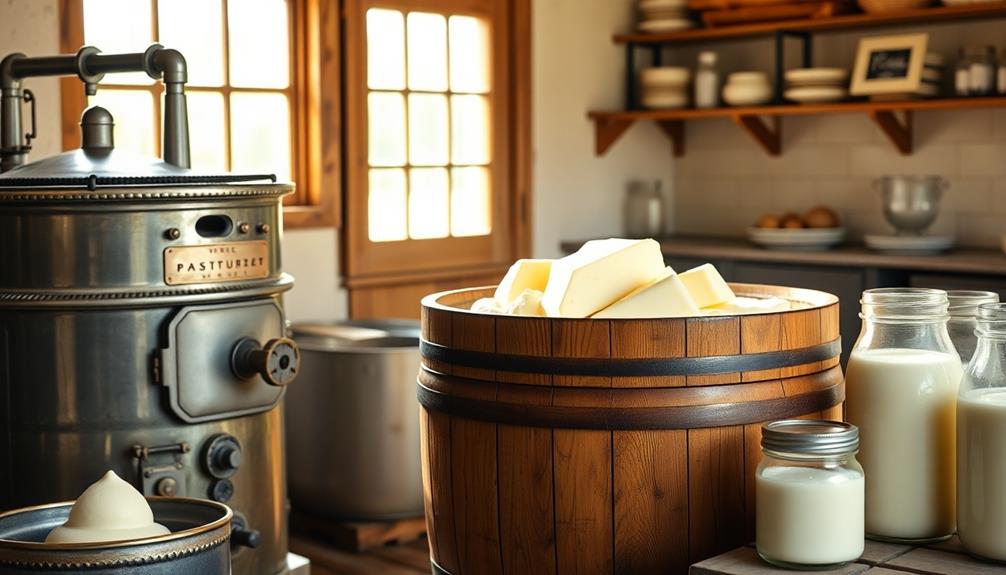
The introduction of pasteurization marked another significant advancement in butter-making technology that improved product safety and quality. By heating the cream before churning, pasteurization eliminates harmful bacteria and pathogens, ensuring that the butter you consume is safer. This process not only protects your health but also extends the shelf life of the finished product. As a result, you can enjoy fresher butter for longer periods.
Additionally, the use of high-quality butter types in conjunction with pasteurization can further enhance the overall flavor experience.
Moreover, pasteurization influences the flavor and texture of butter. You might notice that pasteurized butter often has a more consistent and pleasant taste compared to its raw counterparts. This is because pasteurization helps stabilize the flavor compounds, reducing the risk of off-flavors developing.
Additionally, the emulsifying properties of butter benefit from pasteurization. When you use pasteurized butter in cooking or baking, it blends more effectively with other ingredients, leading to smoother sauces and better-textured baked goods.
Modern Butter Production Methods
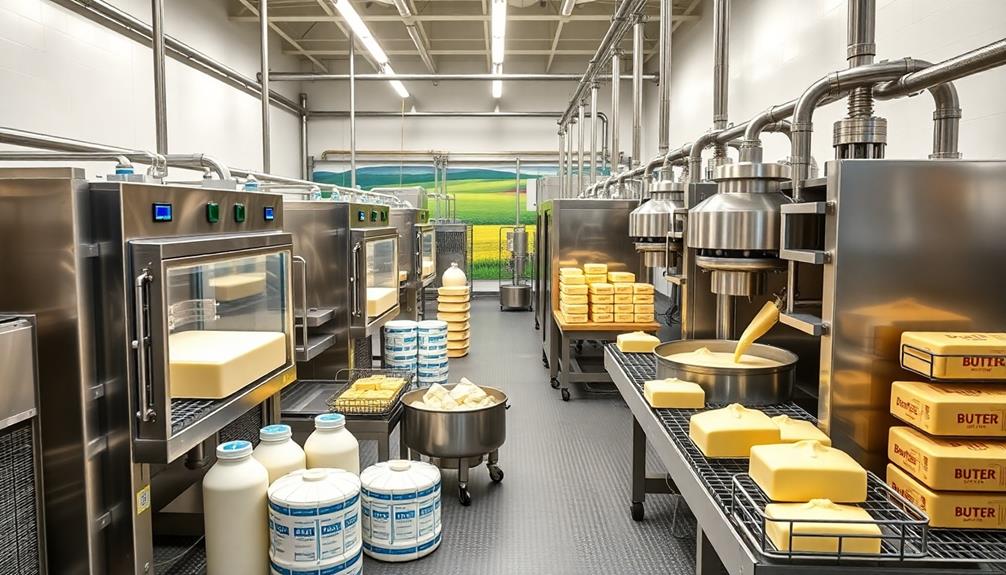
In recent years, modern butter production methods have evolved substantially to meet consumer demands for quality and efficiency.
Today, you'll find that technology plays a vital role in this process, guaranteeing that butter not only tastes great but also meets stringent safety standards.
Here's what's changed in the production landscape:
- High-Temperature Short-Time (HTST) Pasteurization: This technique improves safety while preserving flavor.
- Continuous Butter Making: This method streamlines production, reducing time and labor costs.
- Vacuum Processing: This technique helps eliminate unwanted moisture, enhancing shelf life.
- Advanced Cream Separation: Modern separators allow for precise fat content control, assuring consistency.
- Chilling and Aging Innovations: New cooling systems maintain ideal temperatures for better flavor development.
These advancements help you enjoy a product that's fresher and more consistent than ever before.
Whether you're spreading it on toast or using it in recipes, modern butter production guarantees that you get the best quality every time.
As consumer preferences shift toward healthier and more sustainable options, producers continue to innovate, making butter not just a staple, but a finer culinary experience.
Trends in Artisan Butter Making
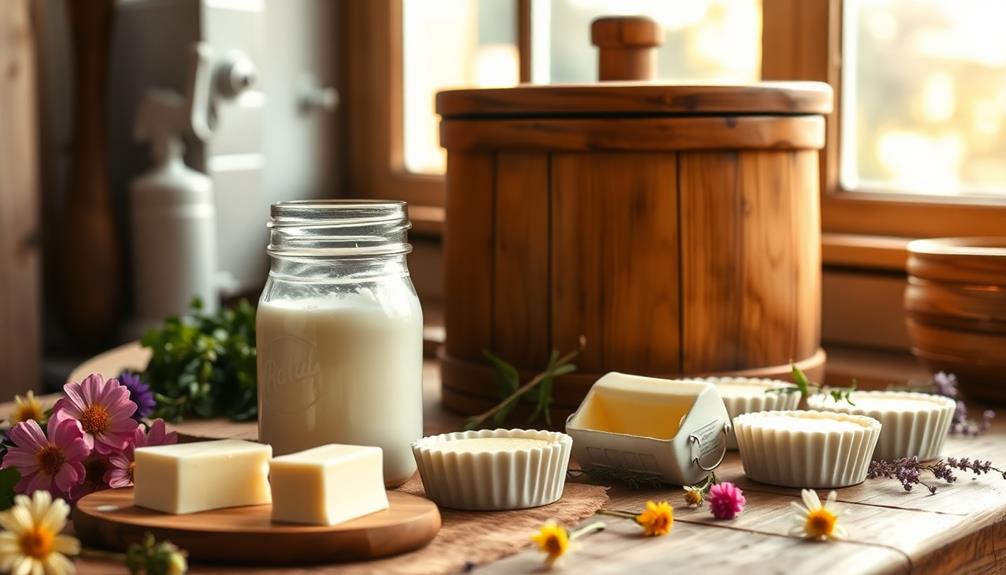
Artisan butter making has seen a surge in popularity among consumers craving unique flavors and high-quality ingredients. You might find small-batch producers experimenting with various milks, like goat, sheep, or even buffalo, to create distinctive taste profiles.
These producers often prioritize local sourcing, supporting nearby farms and ensuring freshness.
Another trend you'll notice is the introduction of flavored butters. From herbs and spices to sweet infusions like honey and fruit, these innovative blends elevate traditional butter into gourmet spreads.
You can easily add excitement to your dishes by incorporating these artisanal options.
Sustainability has also become a key focus in artisan butter making. Many producers emphasize eco-friendly practices, using organic ingredients and minimizing waste during production.
This commitment to sustainability resonates with consumers who value ethical choices.
Future of Butter Technologies

Innovations in butter technologies are set to reshape how you think about this staple ingredient. As we look to the future, several exciting trends are emerging that promise to enhance both the quality and sustainability of butter production.
- Plant-Based Alternatives: New methods are being developed to create butter-like spreads using plant-based ingredients that mimic traditional flavors and textures.
- Smart Production Techniques: IoT devices and AI are being integrated into dairy farms to monitor cow health and milk quality, ensuring superior butter.
- Sustainable Practices: Focus on eco-friendly farming and production processes is leading to more sustainable butter options, reducing the environmental impact.
- Enhanced Flavor Profiles: Innovative aging techniques and flavor infusions are set to create gourmet butters that cater to adventurous palates.
- Health-Conscious Options: With ongoing research, you can expect butter products fortified with vitamins and probiotics, making them healthier choices for you.
As these advancements unfold, you'll find butter not just as a culinary staple but as a product that aligns with your values for health and sustainability.
Embrace the future of butter technologies, and enjoy the new possibilities they bring to your kitchen!
Frequently Asked Questions
What Type of Milk Is Best for Butter Making?
For butter making, you'll want to use high-fat milk, like cream from cow's milk or goat's milk. The richer the milk, the creamier and more flavorful your butter will turn out. Enjoy the process!
How Does Climate Affect Butter Flavor?
Climate influences butter flavor by affecting the milk's composition. Warmer temperatures can enhance the growth of specific bacteria, adding complexity, while cooler climates may produce creamier butter. You'll notice these differences in taste and aroma.
What Are the Health Benefits of Butter?
Imagine butter as sunshine for your body; it fuels your energy and supports vitamin absorption. You'll enjoy its healthy fats, boosting brain function and heart health, while savoring the flavor that brings joy to your meals.
Can Vegan Alternatives Replicate Traditional Butter?
Vegan alternatives can mimic traditional butter's texture and flavor, but they often lack the same richness and nutritional profile. Experimenting with different brands helps you find a satisfying substitute that suits your taste preferences.
How Has Butter Making Influenced Global Cuisines?
Butter's rich flavor and creamy texture enhance dishes worldwide, from savory sauces to baked goods. You'll find it elevating cuisines, creating comfort, and inspiring innovation in recipes, making it an essential ingredient across cultures.
Conclusion
As you explore the fascinating journey of butter making technologies, you realize it's like a rich tapestry woven from tradition and innovation. Each thread tells a story of human ingenuity, adapting to our changing tastes and needs. From ancient techniques to modern methods, butter remains a beloved staple, continually evolving yet rooted in history. As you look ahead, it's clear that the future of butter making will blend heritage with cutting-edge technology, delighting palates for generations to come.
